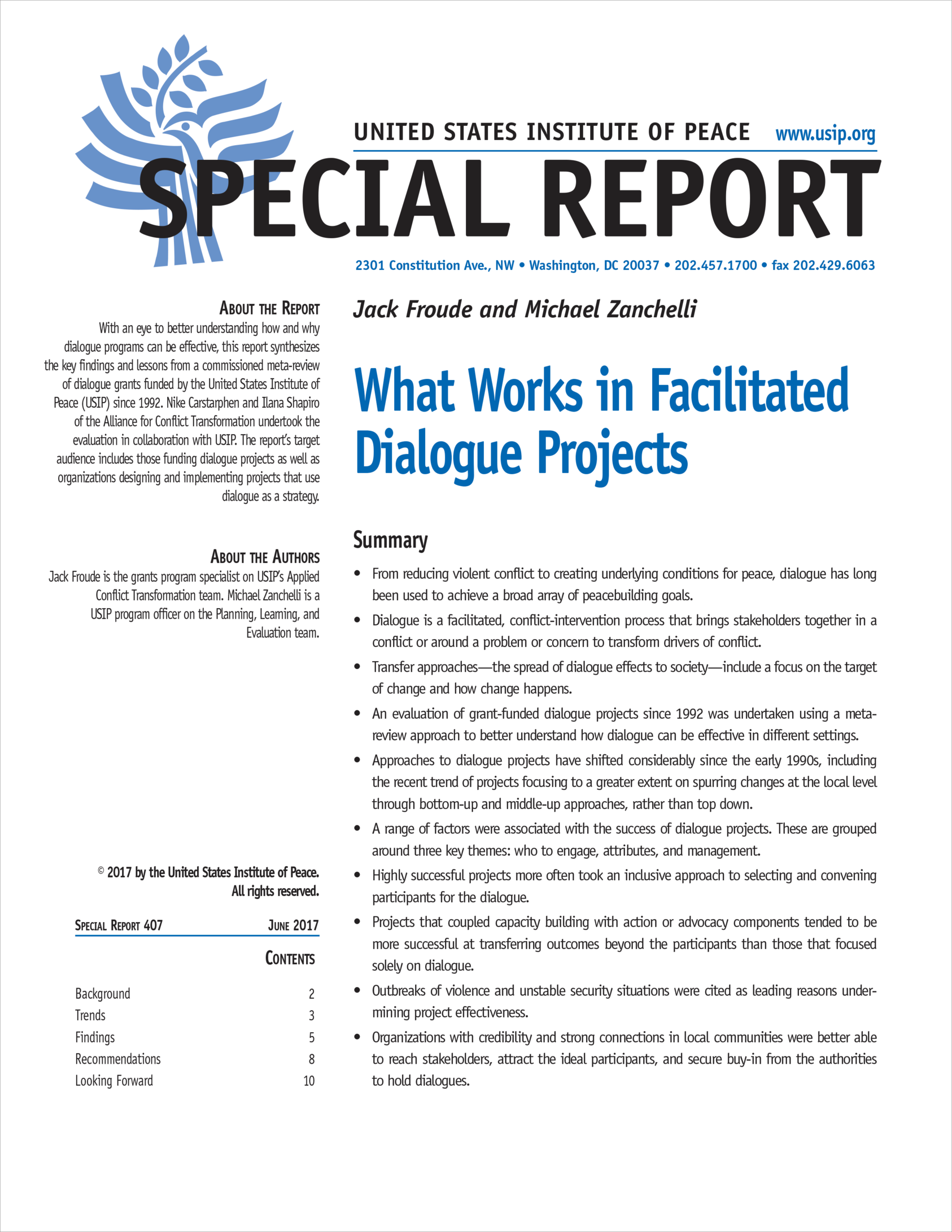From reducing violent conflict to creating underlying conditions for peace, facilitated dialogue has long been used in pursuit of peacebuilding goals. In June 2015, the United States Institute of Peace commissioned a meta-review of its grant-funded dialogue projects since 1992. In an effort to better understand how and why dialogue programs can be effective in different contexts, to enhance future programmatic efforts, and to contribute to the evidence base for the benefit of the broader peacebuilding community, this report synthesizes the key findings from that evaluation.
Summary
- From reducing violent conflict to creating underlying conditions for peace, dialogue has long been used to achieve a broad array of peacebuilding goals.
- Dialogue is a facilitated, conflict-intervention process that brings stakeholders together in a conflict or around a problem or concern to transform drivers of conflict.
- Transfer approaches—the spread of dialogue effects to society—include a focus on the target of change and how change happens.
- An evaluation of grant-funded dialogue projects since 1992 was undertaken using a meta-review approach to better understand how dialogue can be effective in different settings.
- Approaches to dialogue projects have shifted considerably since the early 1990s, including the recent trend of projects focusing to a greater extent on spurring changes at the local level through bottom-up and middle-up approaches, rather than top down.
- A range of factors were associated with the success of dialogue projects. These are grouped around three key themes: who to engage, attributes, and management.
- Highly successful projects more often took an inclusive approach to selecting and convening participants for the dialogue.
- Projects that coupled capacity building with action or advocacy components tended to be more successful at transferring outcomes beyond the participants than those that focused solely on dialogue.
- Outbreaks of violence and unstable security situations were cited as leading reasons undermining project effectiveness.
- Organizations with credibility and strong connections in local communities were better able to reach stakeholders, attract the ideal participants, and secure buy-in from the authorities to hold dialogues.
- During and after the review and evaluation, several questions emerged that would benefit from further exploration. These relate to public sentiment about dialogues, effective strategies to build organizational credibility, the nature of the conflict drivers, and the relationships between dialogues and outcomes, factors and results, and leader characteristics and the dialogue process.
About the Report
With an eye to better understanding how and why dialogue programs can be effective, this report synthesizes the key findings and lessons from a commissioned meta-review of dialogue grants funded by the United States Institute of Peace (USIP) since 1992. Nike Carstarphen and Ilana Shapiro of the Alliance for Conflict Transformation undertook the evaluation in collaboration with USIP. The report’s target audience includes those funding dialogue projects as well as organizations designing and implementing projects that use dialogue as a strategy.
This Special Report is based on findings from the evaluation, “USIP Report on Dialogue Projects and Transfer.”
About the Authors
Jack Froude is the grants program specialist on USIP’s Applied Conflict Transformation team. Michael Zanchelli is a USIP program officer on the Planning, Learning, and Evaluation team.
